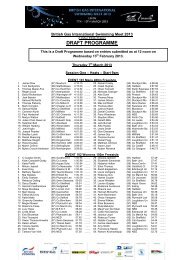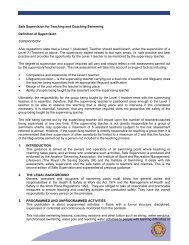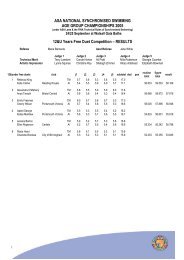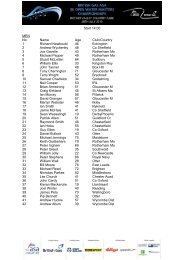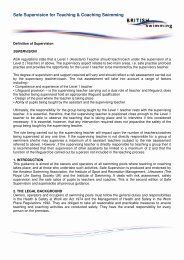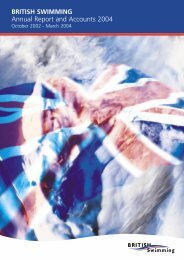Energy efficiency in swimming pools - Swimming.Org
Energy efficiency in swimming pools - Swimming.Org
Energy efficiency in swimming pools - Swimming.Org
You also want an ePaper? Increase the reach of your titles
YUMPU automatically turns print PDFs into web optimized ePapers that Google loves.
Option appraisal<br />
Given a pool which is consum<strong>in</strong>g more energy<br />
than desired as <strong>in</strong>dicated by the ‘typical’ energy<br />
figures (table 1), it is important to consider ways<br />
<strong>in</strong> which it can be made more energy efficient.<br />
Assum<strong>in</strong>g that all the plant is work<strong>in</strong>g correctly,<br />
and the appropriate operational procedures are<br />
adhered to, then <strong>in</strong>vestment <strong>in</strong> energy <strong>efficiency</strong><br />
measures must be considered. <strong>Energy</strong> <strong>efficiency</strong><br />
measures will also need to be considered dur<strong>in</strong>g<br />
refurbishment – for example, when age<strong>in</strong>g plant<br />
may need to be replaced – or when specify<strong>in</strong>g a<br />
new pool.<br />
Typical measures which may be considered<br />
would be:<br />
■ comb<strong>in</strong>ed heat and power (CHP)<br />
■ condens<strong>in</strong>g boilers<br />
■ ventilation heat recovery<br />
■ variable ventilation rates<br />
■ pool water heat recovery.<br />
Each of these offer significant improvements <strong>in</strong><br />
energy <strong>efficiency</strong> and could produce attractive<br />
pay-back periods. However, because of the complex<br />
nature of the energy use <strong>in</strong> a swimm<strong>in</strong>g pool, care<br />
must be taken when calculat<strong>in</strong>g the benefits of<br />
energy <strong>efficiency</strong> measures. If the cost-effectiveness<br />
of each of these is taken <strong>in</strong> isolation it may give a<br />
mislead<strong>in</strong>g impression of the benefits achieved<br />
when they are comb<strong>in</strong>ed. For example, the costeffectiveness<br />
of a CHP system may be lessened as a<br />
consequence of reduced electrical and heat<strong>in</strong>g<br />
demand result<strong>in</strong>g from <strong>in</strong>stall<strong>in</strong>g variable speed<br />
ventilation fans with heat recovery.<br />
To ensure that the most cost-effective techniques<br />
are selected, it is essential that the full range of<br />
energy <strong>efficiency</strong> measures are <strong>in</strong>vestigated by a<br />
process of option appraisal.<br />
It is recommended that a two stage approach is<br />
adopted to assess the benefits of a number of<br />
ENERGY EFFICIENCY IN SWIMMING POOLS<br />
INTRODUCTION<br />
Typical annual energy use<br />
(kWh/m 2 )<br />
Sports centre with pool:<br />
Good Fair Poor<br />
745<br />
Dry sports centre:<br />
Good Fair Poor<br />
410<br />
(Source: <strong>Energy</strong> Consumption Guide 51, ‘<strong>Energy</strong> <strong>efficiency</strong> <strong>in</strong><br />
sports and recreation build<strong>in</strong>gs’, p2)<br />
Table 1<br />
Typical pool operat<strong>in</strong>g costs (%)<br />
Labour 35<br />
Interest on capital 25-35<br />
<strong>Energy</strong> 25-30<br />
Ma<strong>in</strong>tenance, rates and supplies 10-15<br />
Table 2<br />
measures. In the first stage the <strong>in</strong>dividual pay-back<br />
periods of each measure are calculated and the<br />
most cost-effective measure selected as a priority.<br />
The second stage then <strong>in</strong>volves the addition of<br />
the less cost-effective measures <strong>in</strong> turn, and the<br />
calculation of the overall pay-back period for the<br />
package of measures. By this means the<br />
<strong>in</strong>cremental value of each measure – taken <strong>in</strong> the<br />
context of other measures – is more accurately<br />
determ<strong>in</strong>ed, and the risk of adopt<strong>in</strong>g measures<br />
based on unrealistic pay-back periods is<br />
elim<strong>in</strong>ated. This exercise should be carried out<br />
<strong>in</strong> consultation with a competent build<strong>in</strong>g<br />
services eng<strong>in</strong>eer.<br />
6<br />
FURTHER READING<br />
<strong>Energy</strong> Consumption<br />
Guide 51



